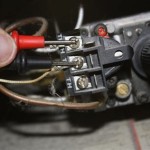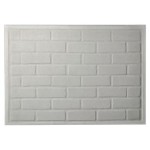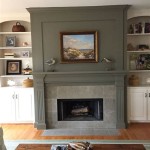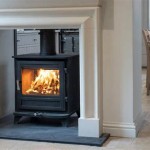Installing Stone Veneer Over a Painted Brick Fireplace
A painted brick fireplace, while potentially possessing a certain charm, can sometimes feel outdated or clash with a desired aesthetic. Installing stone veneer offers a transformative solution, adding texture, character, and value to a home. This process, while achievable for a dedicated do-it-yourselfer, requires careful preparation, meticulous execution, and adherence to best practices to ensure a durable and visually appealing result. This article provides a comprehensive guide to installing stone veneer over a painted brick fireplace, covering essential steps from surface preparation to final sealing.
Before embarking on the project, it is crucial to assess the suitability of the existing structure. The brick fireplace must be structurally sound, capable of supporting the additional weight of the stone veneer and mortar. Any cracks, crumbling brick, or other signs of damage should be addressed before proceeding. Furthermore, the paint on the brick needs to be thoroughly assessed for adhesion. Loose or peeling paint will compromise the bond between the mortar and the brick surface, leading to potential veneer failure. The type of paint used also impacts the preparation method required.
Gathering the necessary tools and materials is the next critical step. This includes stone veneer (natural or manufactured), mortar specifically designed for stone veneer installation, a notched trowel, a margin trowel, a mixing bucket, a drill with a mixing paddle, a level, a measuring tape, a brick hammer or chisel, safety glasses, gloves, a stiff brush, a sponge, and a sealant designed for stone veneer.
Surface Preparation: Ensuring a Solid Foundation
Proper surface preparation is the cornerstone of a successful stone veneer installation. The primary goal is to create a clean, stable, and properly textured surface to which the mortar can effectively bond. This involves several key steps, each contributing to the long-term durability and aesthetic appeal of the finished project.
The initial step is thorough cleaning. The painted brick surface must be free of dust, dirt, grease, and any other contaminants that could interfere with mortar adhesion. This can be achieved using a stiff brush and a solution of trisodium phosphate (TSP) or a similar heavy-duty cleaner. Following the manufacturer's instructions is crucial when using TSP. The surface should be scrubbed vigorously, paying particular attention to crevices and uneven areas. After scrubbing, rinse the surface thoroughly with clean water and allow it to dry completely.
Paint adhesion is the next critical factor to address. If the paint is peeling, flaking, or otherwise poorly adhered, it must be removed. Several methods can be employed, including scraping with a putty knife, wire brushing, or the use of a chemical paint stripper. The choice of method depends on the paint type and the extent of the adhesion problem. If using a chemical stripper, follow the manufacturer's safety precautions and instructions meticulously. After removing loose paint, the remaining paint should be thoroughly roughened to provide a better key for the mortar. This can be achieved by scoring the surface with a wire brush or using a grinding tool equipped with a coarse sanding disc. The aim is to create a profile that the mortar can grip effectively.
Once the surface is cleaned and the paint adhesion is addressed, the application of a scratch coat is highly recommended, especially over painted surfaces. A scratch coat is a thin layer of mortar applied directly to the prepared brick surface. This layer provides an additional bonding surface for the stone veneer and helps to level out any minor imperfections in the brick. The mortar used for the scratch coat should be the same type as that used for setting the stone veneer. Apply the scratch coat with a notched trowel, creating horizontal grooves in the mortar. These grooves provide a mechanical key for the veneer, further enhancing adhesion. Allow the scratch coat to cure for at least 24 hours before proceeding with the stone veneer installation.
Finally, before applying the stone veneer, dampen the scratch coat lightly with water. This helps to prevent the mortar from drying out too quickly and ensures a stronger bond. Avoid saturating the scratch coat, as this can weaken the bond.
Stone Veneer Installation: Mortar Application and Stone Placement
The actual installation of the stone veneer requires careful attention to detail and a systematic approach. The goal is to create a visually appealing and structurally sound veneer that will last for years to come. Proper mortar mixing, application, and stone placement are essential to achieving this objective.
Start by carefully mixing the mortar according to the manufacturer's instructions. The consistency of the mortar is crucial for proper adhesion. It should be thick enough to hold the stone veneer in place but still pliable enough to spread easily. Use a drill with a mixing paddle to ensure a consistent and lump-free mix. Avoid adding too much water, as this can weaken the mortar and lead to sagging or slippage of the veneer. Mortar color can be adjusted to match or contrast with the stone veneer. Pigments specifically designed for mortar should be used to avoid altering the mortar's strength or drying time.
Begin the installation process at the bottom of the fireplace, working upwards. This allows gravity to assist in holding the stones in place. Apply a generous layer of mortar to the back of the first stone veneer unit. The mortar should be thick enough to fill any gaps or irregularities in the stone. Press the stone firmly into place on the prepared surface, ensuring that it is level and aligned with the adjacent stones. Use a level to check the horizontal and vertical alignment of each stone as it is placed. Slight adjustments can be made to the stone's position while the mortar is still wet.
Maintain consistent spacing between the stones to create a uniform appearance. Spacing can be achieved using small wooden shims or plastic spacers. The width of the joints between the stones is a matter of personal preference, but a consistent width is important for aesthetic appeal. Remove any excess mortar that squeezes out from between the stones immediately using a margin trowel. This prevents the mortar from hardening and becoming difficult to remove later.
When cutting stone veneer to fit around corners or other irregular shapes, use a brick hammer and chisel or a wet saw. Wear safety glasses to protect your eyes from flying debris. Ensure that the cut edges are clean and smooth before placing the stone. Stagger the joints between the stones to create a more natural and visually appealing appearance. Avoid creating long, continuous vertical or horizontal joints, as these can be structurally weak points.
As you work upwards, periodically check the overall appearance of the veneer. Step back and view the fireplace from different angles to ensure that the stones are properly aligned and that the spacing is consistent. Make any necessary adjustments while the mortar is still wet.
Grouting and Sealing: Finishing Touches for Durability and Aesthetics
After the stone veneer has been installed and the mortar has cured for the recommended time (typically 24-48 hours), the joints between the stones need to be grouted. Grouting fills the gaps between the stones, providing a finished look and preventing water from penetrating behind the veneer. Sealing the stone veneer is the final step, providing protection from the elements and enhancing its durability.
The grout used for stone veneer should be a mortar mix specifically designed for grouting. This type of mortar is typically finer in texture and easier to work with than the mortar used for setting the stones. Mix the grout according to the manufacturer's instructions, ensuring that it is a smooth, consistent paste.
Apply the grout to the joints between the stones using a grout bag or a pointing trowel. Fill the joints completely, pressing the grout firmly into place. Avoid getting grout on the face of the stone veneer, as this can be difficult to remove. If grout does get on the stone, wipe it off immediately with a damp sponge.
Once the grout has been applied, use a jointing tool or a rounded object to shape the grout joints. The shape of the joints is a matter of personal preference, but a consistent shape is important for aesthetic appeal. Common joint shapes include concave, flush, and raked. Remove any excess grout from the joints using a brush.
Allow the grout to cure for the recommended time, typically 24-48 hours. After the grout has cured, clean the stone veneer thoroughly with a stiff brush and a solution of water and mild detergent. This will remove any remaining grout residue and reveal the natural beauty of the stone.
Finally, apply a sealant specifically designed for stone veneer. The sealant will protect the stone from water damage, staining, and fading. Choose a sealant that is appropriate for the type of stone veneer you have installed. Follow the manufacturer's instructions carefully when applying the sealant. Apply the sealant evenly, ensuring that all surfaces of the stone are coated. Allow the sealant to dry completely before exposing the stone veneer to the elements.
By following these steps carefully, installing stone veneer over a painted brick fireplace can be a rewarding project that transforms the look of a home. The final result is a beautiful and durable fireplace that will be enjoyed for years to come. Remember to consult with a professional if you have any doubts or concerns about any aspect of the installation process.

Stone Veneer Over A Brick Fireplace Updates The Look

Can Stone Veneer Be Applied Over Brick Deluca Masonry Construction

Stone Veneer Over A Brick Fireplace Updates The Look
Stacked Stone Over Painted Fireplace Hearth Com Forums Home

See How I Made Over An Ugly Clunky Stone Veneer Fireplace With Paint

How To Cover A Brick Fireplace With Stone

Installing Stone Veneer Over A Brick Fireplace Grand River

See How I Made Over An Ugly Clunky Stone Veneer Fireplace With Paint

Stone Veneer Over A Brick Fireplace Updates The Look

Stone Veneer Fireplace Makeover Our Client Wanted To Update His Brick They Want
Related Posts








